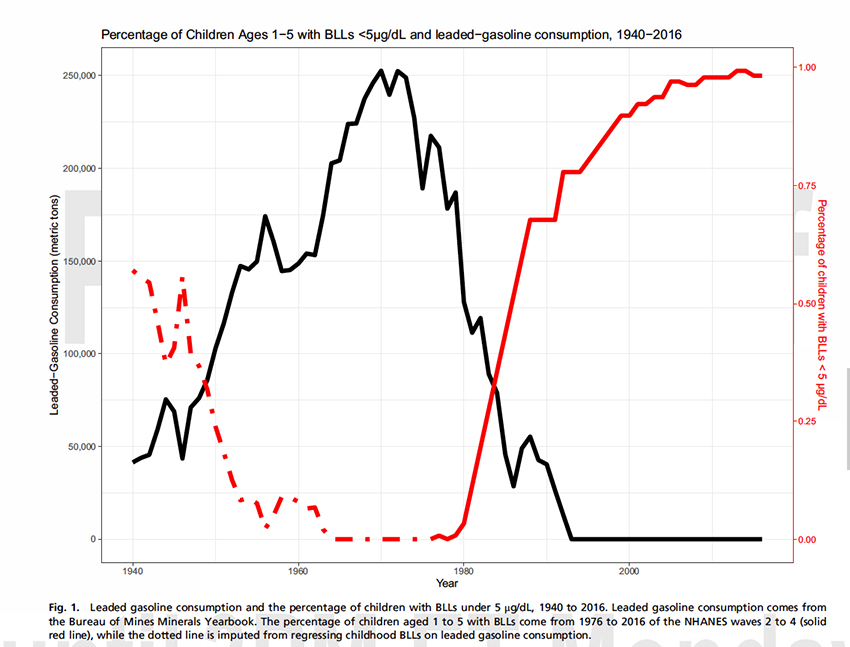A commentary on this article by our Board of Scientific Advisors' Susan Goldhaber can be found here.
The researcher’s “analytic strategy” is straightforward. They used blood levels of lead found in participants in the NHANES - National Health and Nutrition Examination Survey, providing data back to 1976. To extrapolate further back in time, to 1940, they took the amount of lead present then and in 1976 to develop a conversion factor and translate 1976 values into presumptive 1940 values. The basis of that conversion is that most of the environmental lead came from leaded gasoline. These black lines in the graphic show the changing amounts of leaded gasoline sold until it was banned in 1996.

The red lines show the percentage of children with levels of lead <5 μg/dL, our current “acceptable” standard, the cutoff before clinical concern. The broken red line is the extrapolation levels. We are doing pretty good now, especially in contrast to the years before the ban, and especially the age of the Boomers. Through additional calculations, using each age cohort in the population, they could determine what percentages of the population were exposed to lead levels of more than 5 μg/dL. Those calculations yielded some impressive and concerning numbers. As of 2015,
- 54% of the population had been exposed to lead at blood levels >5 μg/dL
- 31% of the population had been exposed to lead at blood levels >10 μg/dL
- 10% of the population had been exposed to lead at blood levels >25 μg/dL
- 90% or more of the children born between 1950 and 1980 had blood lead levels of clinical concern – today, that percentage is 1%
Take-away 1 – Banning leaded gasoline has been a very successful policy decision. To use a phrase that I have become enamored with, this is policy-based evidence of the highest order.
Now for some Mathmagic
The researchers' goal was to present this information in a way that would demonstrate some of the ill effects of lead. They chose to consider how lead deleteriously impacts our thinking abilities and used IQ as the measure. Now why they chose IQ, a controversial measure, to begin with, is unclear, but as they write, they chose the “one outcome domain with a well-established lead dose-response relationship—cognitive ability.” [1] Having found a study that correlated blood lead levels with IQ, it was simply a matter of Mathmagic to calculate the loss of IQ from this lead exposure in childhood.
“A total of 824,097,690 million IQ points were lost because of childhood lead exposure among the US population by 2015. This number equates to an average of 2.6 IQ point deficit per person.”
That average does vary with age group, but it is safe to say that the Boomers are leading the way on cognitive loss closer to the 5 point range. But before moving on, we might take a moment to look at the study of lead’s “dose-response relationship” to IQ; it is, after all, the basis of that final tally.
This study was performed in 2005 involving data from seven ongoing studies of blood lead levels on IQ testing. It included groups in the US, Mexico, Australia, and Yugoslavia. Of the roughly 1300 children, the lifetime average blood lead level was 12.4 μg/dL, with a median peak of 18 μg/dL at the age of 2½. Their mean IQ was 93. Among the mothers, 34% smoked during their pregnancy, and 20% drank alcohol; but what really stood out was their median IQ of 88. What up with that? While the average IQ, by definition, is 100, 90 is within the normal range, and 88 is “close enough for government work.” This was a “benchmark” study, but certainly, there seems to be some unintentional bias in the selection of mothers and perhaps some confounding by the use of tobacco and alcohol during pregnancy.
Take-away 2 – The extrapolation is only as strong as its weakest link. You have to look at the citations to get the total sense of the findings unless you are already an expert in the area.
Has environmental lead cause some health issues, undoubtedly. But did the Boomers really lose that many IQ points? And how could you tell? What I found most interesting was the dramatic change in blood lead levels over my lifetime. In an era when we are so untrusting of policy, especially environmental regulations, isn’t worthwhile to say how some of our actions can make tremendous differences.
[1] The choice of using IQ is reminiscent of the story of the drunk looking only under the streetlights for his keys as they were the areas lit well enough to see.
Source: Half of US population exposed to adverse lead levels in early childhood Proceedings National Academy of Science DOI: 10.1073/pnas.2118631119




